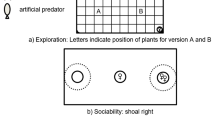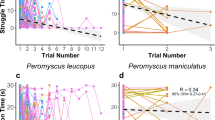Abstract
Recently, integration of personality traits into a ‘pace-of-life syndrome’ (POLS) context has been advocated. To be able to understand how an individual’s behavioural, physiological and life history traits may coevolve, we need to jointly quantify these traits in order to study their covariance. Few studies have established links between personality and immunity properties of an individual. We here examined covariation of a measure of skeletal size (tarsus length), three behavioural traits (activity, handling aggression and breath rate) and two immunological traits (IgG level and haematocrit), in 592 wild caught blue tits. Many individuals (201) were tested more than once, allowing quantification of individual consistency of all traits and partition of the covariances between the traits, using a multivariate mixed model, into between individual and residual covariances. We find individual consistency of all behavioural traits, indicating that these capture aspects of blue tit adult personality and also the physiological measures are repeatable. Contrary to the POLS expectation, we find no overall significant individual level correlation structure between these traits and a factor analytical approach confirmed that between individual correlations across traits were not due to a common (POLS) factor or driven by size (tarsus length). Based on a published power study, we conclude that there is no common syndrome of individual level covariance between personality and physiological traits in wild blue tits or that the effect sizes, such a syndrome generates, are too low (r < 0.3) to detect. Future field-based work should be designed to explore low effect sizes and strive to measure specific traits whose involvement is implicated to have large effect sizes as based on, e.g. laboratory findings.
Similar content being viewed by others
References
Apanius V, Nisbet ICT (2006) Serum immunoglobulin G levels are positively related to reproductive performance in a long-lived seabird, the common tern (Sterna hirundo). Oecologia 147:12–23
Baugh AT, Schaper SV, Hau M, Cockrem JF, de Goede P, Oers K (2012) Corticosterone responses differ between lines of great tits (Parus major) selected for divergent personalities. Gen Comp Endocrinol 175:488–494
Bell AM, Hankison SJ, Laskowski KL (2009) The repeatability of behaviour: a meta-analysis. Anim Behav 77:771–783
Brommer JE (2013a) On between individual and residual (co)variances in the study of animal personality: are you willing to make the individual gambit? Behav Ecol Sociobiol 67:1027–1032
Brommer JE (2013b) Variation in plasticity of personality traits implies that the ranking of personality measures changes between environmental contexts: calculating the cross-environmental correlation. Behav Ecol Sociobiol 67:1709–1718
Brommer JE, Kluen E (2012) Exploring the genetics of nestling personality traits in a wild passerine bird: testing the phenotypic gambit. Ecol Evol 2:3032–3044
Careau V, Thomas D, Pelletier F, Turki L, Landry F, Garant D, Réale D (2011) Genetic correlation between resting metabolic rate and exploratory behaviour in deer mice (Peromyscus maniculatus). J Evol Biol 24:2153–2163
Carere C, van Oers K (2004) Shy and bold great tits (Parus major): body temperature and breath rate in response to handling stress. Physiol Behav 82:905–912
Carere C, Drent PJ, Privitera L, Koolhaas JM, Groothuis TGG (2005) Personalities in great tits (Parus major): stability and consistency. Behaviour 142:1329–1355
Cockrem J (2007) Stress, corticosterone responses and avian personalities. J Ornithol 148:169–178
David M, Auclair Y, Dechaume-Moncharmont F-X, Cézilly F (2011) Handling stress does not reflect personality in female zebra finches (Taeniopygia guttata). J Comp Psychol 126:10–14
Dingemanse NJ, Dochtermann NA (2013) Quantifying individual variation in behaviour: mixed-effect modelling approaches. J Anim Ecol 82:39–54
Dingemanse NJ, Both C, Drent PJ, van Oers K, van Noordwijk AJ (2002) Repeatability and heritability of exploratory behaviour in great tits from the wild. Anim Behav 64:929–937
Dingemanse NJ, Both C, Drent PJ, Tinbergen JM (2004) Fitness consequences of avian personalities in a fluctuating environment. Proc R Soc Lond B 271:847–852
Dingemanse NJ, Dochtermann N, Wright J (2010) A method for exploring the structure of behavioural syndromes to allow formal comparison within and between data sets. Anim Behav 79:439–450
Dingemanse NJ, Dochtermann NA, Nakagawa S (2012) Defining behavioural syndromes and the role of ‘syndrome deviation’ in understanding their evolution. Behav Ecol Sociobiol 66:1543–1548
Fair J, Whitaker S, Pearson B (2007) Sources of variation in haematocrit in birds. Ibis 149:535–552
Falconer DS, MacKay TFC (1996) Introduction to quantitative genetics, 4th edn. Longman, Harlow
Fox J (2006) Structural equation modelling with the sem package in R. Struct Equ Modeling 13:465–486
Fucikova E, Drent PJ, Smits N, van Oers K (2009) Handling stress as a measurement of personality in great tit nestlings (Parus major). Ethology 115:366–374
Grafen A (1988) On the uses of lifetime reproductive success. In: Clutton-Brock TH (ed) Reproductive success. University of Chicago Press, Chicago
Harrison GH, Harrsion LR (1986) Clinical avian medicine and surgery. WB Saunders, Philadelphia
Kluen E, Brommer JE (2013) Context-specific repeatability of personality traits in a wild bird: a reaction-norm perspective. Behav Ecol 24:650–658
Kluen E, Kuhn S, Kempenaers B, Brommer JE (2012) A simple cage-test captures intrinsic differences in aspects of personality across individuals in a passerine bird. Anim Behav 84:279–287
Koolhaas JM (2008) Coping style and immunity in animals: making sense of individual variation. Brain Behav Immun 22:662–667
Koolhaas JM, Korte SM, de Boer SF, van der Vegt BJ, van Reenen CG, Hopster H, de Jong IC, Ruis MAW, Blokhuis HJ (1999) Coping styles in animals: current status in behaviour and stress-physiology. Neurosci Biobehav Rev 23:925–935
Korte SM, Koolhaas JM, Wingfield JC, McEwen BS (2005) The Darwinian concept of stress: benefits of allostasis and costs of allostatic load and the trade-offs in health and disease. Neurosci Biobehav Rev 29:3–38
Lynch M, Walsh B (1998) Genetics and analysis of quantitative traits. Sinauer, Sunderland
Lynn SE, Houtman AM, Weathers WW, Ketterson ED, Nolan V (2000) Testosterone increases activity but not daily energy expenditure in captive male dark-eyed juncos, Junco hyemalis. Anim Behav 60:581–587
Nakagawa S, Schielzeth H (2010) Repeatability for Gaussian and non‐Gaussian data: a practical guide for biologists. Biological Reviews 85: 935–956
Ots I, Murumägi A, Hõrak P (1998) Haematological health state indices of reproducing great tits: methodology and sources of natural variation. Funct Ecol 12:700–707
Ottoni EB (2000) EthoLog 2.2—a tool for the transcription and timing of behavior observation sessions. Behav Res Meth Instrum C 32:446–449
Pihlaja M, Siitari H, Alatalo R (2006) Maternal antibodies in a wild altricial bird: effects on offspring immunity, growth and survival. J Anim Ecol 75:1154–1164
Réale D, Gallant BY, Leblanc M, Festa-Bianchet M (2000) Consistency of temperament in bighorn ewes and correlates with behaviour and life history. Anim Behav 60:589–597
Réale D, Reader SM, Sol D, McDougall P, Dingemanse NJ (2007) Integrating temperament in ecology and evolutionary biology. Biol Rev 82:291–318
Réale D, Dingemanse NJ, Kazem AJN, Wright J (2010) Evolutionary and ecological approaches to the study of personality. Philos Trans R Soc Lond B 365:3937–3946
Sih A, Bell AM, Johnson JC (2004a) Behavioral syndromes: an ecological and evolutionary overview. Trends Ecol Evol 19:372–378
Sih A, Bell AM, Johnson JC, Ziemba RE (2004b) Behavioural syndromes: an integrative overview. Q Rev Biol 79:241–277
Sild E, Sepp T, Hõrak P (2011) Behavioural trait covaries with immune responsiveness in a wild passerine. Brain Behav Immun 25:1349–1354
Silverin B (1986) Corticosterone-binding proteins and behavioral effects of high plasma levels of corticosterone during the breeding period in the pied flycatcher. Gen Comp Endocrinol 64:67–74
Silverin B (1998) Behavioural and hormonal responses of the pied flycatcher to environmental stressors. Anim Behav 55:1411–1420
Sinn DL, Apiolaza LA, Moltschaniwskyj NA (2006) Heritability and fitness-related consequences of squid personality traits. J Evol Biol 19:1437–1447
Stamps JA, Groothuis TGG (2010) Ontogeny of animal personality: relevance, concepts and perspectives. Biol Rev 85:301–325
Svensson L (1992) Identification guide to European passerines. Märstatryck, Stockholm
van Oers K, Drent PJ, de Jong G, van Noordwijk AJ (2004) Additive and nonadditive genetic variation in avian personality traits. Heredity 93:496–503
van Oers K, de Jong G, van Noordwijk AJ, Kempenaers B, Drent PJ (2005) Contribution of genetics to the study of animal personalities: a review of case studies. Behaviour 142:1191–1212
Wingfield JC, Ball GF, Dufty AM, Hegner RE, Ramenofsky M (1987) Testosterone and aggression in birds. Am Sci 75:602–608
Zuur AF, Ieno EN, Walker NJ, Saveliev AA, Smith GM (2009) Mixed effects models and extensions in ecology with R. Springer, New York
Acknowledgments
Maaike de Heij, Jaana Kekkonen and Lasse Kurvinen are thanked for their assistance in the field. Several land owners kindly allowed us to work on their properties. Kees van Oers, Alecia Carter, Niels J. Dingemanse and an anonymous reviewer provided comments that helped improve this manuscript.
Author information
Authors and Affiliations
Corresponding author
Additional information
Communicated by N. Dingemanse
Electronic supplementary material
Below is the link to the electronic supplementary material.
ESM 1
(DOC 55 kb)
Rights and permissions
About this article
Cite this article
Kluen, E., Siitari, H. & Brommer, J.E. Testing for between individual correlations of personality and physiological traits in a wild bird. Behav Ecol Sociobiol 68, 205–213 (2014). https://doi.org/10.1007/s00265-013-1635-1
Received:
Revised:
Accepted:
Published:
Issue Date:
DOI: https://doi.org/10.1007/s00265-013-1635-1




